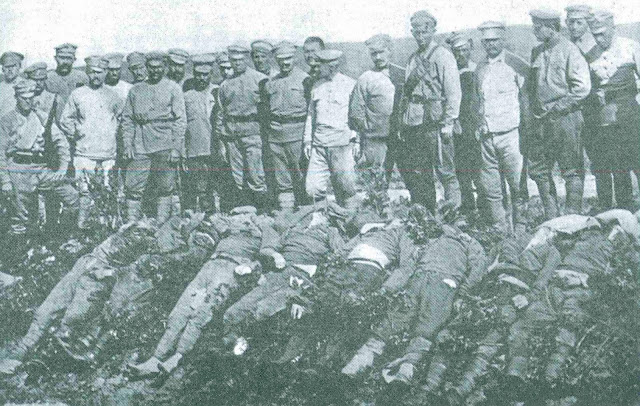In July 1918, Czechoslovak Legion soldiers were killed by the Russian Red Army in Ussuriysk, in the Russian Far East, shortly after the country's departure from World War I. The Czechoslovak Legion soldiers accumulated the corpses of their murdered comrades and surrounded them. By June, both sides were fighting along the Trans-Siberian Railway from Penza to Krasnoyarsk.
By the end of June 1918, Vladivostok was overrun by the Czechoslovak Legion and declared an Allied protectorate. The city was made a landing point for Japanese, American, French, and British forces relieving the White Army, and by mid-July the Czechoslovak Legion, along with its White allies, had overrun all cities on the Trans-Siberian route from Samara to the Pacific Ocean. As Allied forces closed in on Yekaterinburg in the Urals, where the last Russian emperor, Nicholas II, was imprisoned, the Bolshevik Red Army promptly executed Nicholas II and his family by firing squad on July 17. They buried them in the woods along the Kopchaki Road, and on July 25 the Czechoslovak Legion overran Yekaterinburg.
On August 5, 1914, the Czechoslovak Legion was organized within the Russian Imperial Army to fight against Austrian and allied forces to establish a state; in November 1917, the Bolsheviks seized power throughout Russia. The Czechoslovak Legion set out from the Ukraine along the Russian railroads to transports from the port of Vladivostok in the Far East. on March 3, 1918, the Treaty of Brest-Litovsk withdrew the Russian Imperial Army from the First World War.
By the end of August 1918, the Czechoslovak Legion was in control of Vladivostok. In early July 1918, American, Japanese, and other forces deployed to Vladivostok, Siberia, to rescue Czechoslovak troops who had been held back by the Bolsheviks in Transbaikal. soldiers sought to return to their homeland.
On November 14, 1919, the Red Army occupied Omsk, the capital of the White Army, and a desperate flight to the east by the White Army and refugees along the Trans-Siberian Railway began; on February 7, 1920, the Czechoslovak Legion signed a truce with the Red Army in Kuching; on March 1, 1920, the last Czechoslovak train, Irkutsk on the Trans-Siberian Railway and withdrew by sea from the port of Vladivostok to take refuge in their homeland. The total number of people evacuated with the Czechoslovak Legion in Russia was 67,739, and approximately 4,112 people were killed in Russia during World War I and the Russian Revolution.




No comments:
Post a Comment